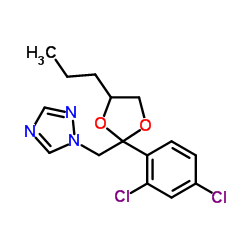丙环唑

丙环唑结构式

|
常用名 | 丙环唑 | 英文名 | propiconazole |
|---|---|---|---|---|
| CAS号 | 60207-90-1 | 分子量 | 342.220 | |
| 密度 | 1.4±0.1 g/cm3 | 沸点 | 480.0±55.0 °C at 760 mmHg | |
| 分子式 | C15H17Cl2N3O2 | 熔点 | N/A | |
| MSDS | 美版 | 闪点 | 244.1±31.5 °C | |
| 符号 |


GHS06, GHS09 |
信号词 | Danger |
|
Assessing the potential for algae and macrophytes to degrade crop protection products in aquatic ecosystems.
Environ. Toxicol. Chem. 30(3) , 622-31, (2011) Rates of pesticide degradation in aquatic ecosystems often differ between those observed within laboratory studies and field trials. Under field conditions, a number of additional processes may well have a significant role, yet are excluded from standard labo... |
|
|
Analysis of microRNA and gene expression profiling in triazole fungicide-treated HepG2 cell line.
Toxicology 303 , 94-8, (2013) MicroRNA (miRNA) plays an important role in various diseases and in cellular and molecular responses to toxicants. In the present study, we investigated differential expression of miRNAs in response to three triazole fungicides (myclobutanil, propiconazole, a... |
|
|
Quantitative changes in endogenous DNA adducts correlate with conazole in vivo mutagenicity and tumorigenicity.
Mutagenesis 27(5) , 541-9, (2012) The mouse liver tumorigenic conazole fungicides triadimefon and propiconazole have previously been shown to be in vivo mouse liver mutagens in the Big Blue™ transgenic mutation assay when administered in feed at tumorigenic doses, whereas the nontumorigenic c... |
|
|
Comparative chemometric modeling of cytochrome 3A4 inhibitory activity of structurally diverse compounds using stepwise MLR, FA-MLR, PLS, GFA, G/PLS and ANN techniques.
Eur. J. Med. Chem. 44 , 2913-22, (2009) Twenty-eight structurally diverse cytochrome 3A4 (CYP3A4) inhibitors have been subjected to quantitative structure-activity relationship (QSAR) studies. The analyses were performed with electronic, spatial, topological, and thermodynamic descriptors calculate... |
|
|
Phenobarbital and propiconazole toxicogenomic profiles in mice show major similarities consistent with the key role that constitutive androstane receptor (CAR) activation plays in their mode of action.
Toxicology 321 , 80-8, (2014) Toxicogenomics (TGx) is employed frequently to investigate underlying molecular mechanisms of the compound of interest and, thus, has become an aid to mode of action determination. However, the results and interpretation of a TGx dataset are influenced by the... |
|
|
Triazole fungicides can induce cross-resistance to medical triazoles in Aspergillus fumigatus.
PLoS ONE 7(3) , e31801, (2012) Azoles play an important role in the management of Aspergillus diseases. Azole resistance is an emerging global problem in Aspergillus fumigatus, and may develop through patient therapy. In addition, an environmental route of resistance development has been s... |
|
|
The hepatocarcinogenic conazoles: cyproconazole, epoxiconazole, and propiconazole induce a common set of toxicological and transcriptional responses.
Toxicol. Sci. 127(1) , 54-65, (2012) Conazoles are fungicides used as agricultural pesticides and pharmaceutical products. We investigated whether a common core of toxicological and transcriptional responses underlies the observed carcinogenic effects of three conazoles: cyproconazole, epoxicona... |
|
|
Use of industrial byproducts to filter phosphorus and pesticides in golf green drainage water.
J. Environ. Qual. 40(4) , 1273-80, (2011) Golf courses are vulnerable to phosphate (PO) and pesticide loss by infiltration of the sandy, porous grass rooting media used and through subsurface tile drainage. In this study, an effort was made to remove PO, chlorothalonil, mefenoxam, and propiconazole i... |
|
|
Development of a difenoconazole/propiconazole microemulsion and its antifungal activities against Rhizoctonia solani AG1-IA.
Pharmazie 67(6) , 534-41, (2012) According to its physical and chemical properties, the composition of difenoconazole/propiconazole microemulsion was as follows: xylene as solvent, emulsifier HSH as surfactant and methanol as cosurfactant. The optimal formulation of difenoconazole/propiconaz... |
|
|
Mixture toxicity of wood preservative products in the fish embryo toxicity test.
Environ. Toxicol. Chem. 31(6) , 1239-48, (2012) Wood preservative products are used globally to protect wood from fungal decay and insects. We investigated the aquatic toxicity of five commercial wood preservative products, the biocidal active substances and some formulation additives contained therein, as... |